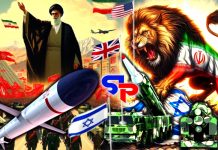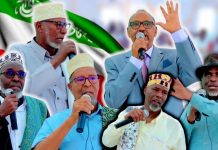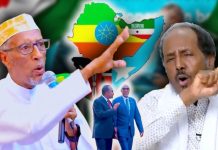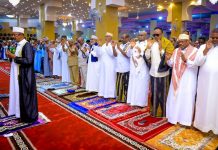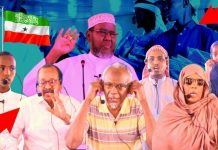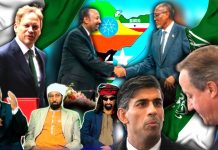BY: ABDI HUSSEIN DAUD
 For the past two decades, southern Somalia has been plagued by sporadic and unrelenting civil war, terrorism, pirates, famine, and wide spread diseases which claimed the lives of up to 200,000 to 300,000 people. The persistent multifarious ordeals that ordinary citizens have endured thus far are widely reported by the international media as well as humanitarian agencies. Since its effects and magnitude have been extensively scrutinized elsewhere, it is futile to reiterate in here. There have been fourteen reconciliation attempts aimed at restoring peace and stability in southern Somalia but all have failed to yield the intended objectives. Subsequently, southern Somalia became, as international community describes it, a failed state due to its manifestation of all its hallmarks: an ineffective government, widespread corruption, lack of public services, prevalent criminal enterprise, economic decline, and muddled movement of populations.
For the past two decades, southern Somalia has been plagued by sporadic and unrelenting civil war, terrorism, pirates, famine, and wide spread diseases which claimed the lives of up to 200,000 to 300,000 people. The persistent multifarious ordeals that ordinary citizens have endured thus far are widely reported by the international media as well as humanitarian agencies. Since its effects and magnitude have been extensively scrutinized elsewhere, it is futile to reiterate in here. There have been fourteen reconciliation attempts aimed at restoring peace and stability in southern Somalia but all have failed to yield the intended objectives. Subsequently, southern Somalia became, as international community describes it, a failed state due to its manifestation of all its hallmarks: an ineffective government, widespread corruption, lack of public services, prevalent criminal enterprise, economic decline, and muddled movement of populations.
In sharp contrast to southern Somalia, Somaliland has successfully constructed the first democratic state of its kind in the Horn of Africa with emerging laissez-faireeconomy. Notwithstanding its challenges, Somaliland has formulated legal frameworks intended for the extension of democratic institutions, e.g., various political parties, free and fair elections, due process of law, freedom of assembly, freedom of association, freedom of the press, and, above all, peaceful and democratic transfer of power. It is indeed an oasis of peace, democracy and prosperity. How did Somaliland manage, you may correctly inquire, attain this unprecedented triumphant while their counterpart, southern Somalia, has constantly failed to restore peace, let alone construct any type of governance?
To provide impartial answer to the aforesaid inquiry, this short piece strives to scrutinize the underlying factor that has played significant role for the failure of southern Somalia as well as the unprecedented success of Somaliland. Numerous individuals who have attempted to inspect the fundamental causes of these differences failed miserably to appreciate and employ the principle of historical materialism. Historical materialism holds that in order to unearth the causes of social phenomenon, it is essential to peel back its multilayered sequence of events. In other words, to unearth the initial cause of any phenomenon, it is crucial to trace its evolution without falling into the trap of circular reasoning.
Most analysts in this case, however, portray their examination as if Somali tribulations have no historical precedent by focusing chiefly on the effects rather than the causes. The dire consequence of examining and concentrating on effects, rather than the causes, resembles the lethal upshot of a doctor who incorrectly diagnoses the symptoms of his/her patient(s) and subscribes improper treatments. The most regurgitated and blamed effects include, but not limited to: clan-ism, leadership failure, warlord politics, terrorism, foreign entities, etc. Although these effects play a role in Somalia’s tribulations, they are neither the root causes of southern Somalia’s failure nor Somaliland’s success. As the doctor analogy illustrates, focusing on effects or symptoms rather than the cause leads to providing or suggesting wrong diagnosis.
This article endeavors to scrutinize the primary underlying causes of the divergence path that the two regions have taken. It argues that the root cause of the southerners’ failure and Somaliland’s triumph lies solely on the role, or lack thereof, that traditional institutions have played in both regions. This argument examines three epochs: the pre-colonial era wherein Somali traditional institutions were intact and functional; the colonial epoch during which British colony assisted Somaliland blend the traditional institutions with modern institutions whereas Italians crushed the traditional institutions of southern Somali; and the post-colonial period in which the product of the colonial legacy manifests itself in both regions. As we shall see, the southern Somalis’ traditional institutions were destroyed by Italian colony whereas Somaliland ’s survived.
To demonstrate this hypothesis, this article chronicles briefly the historical trajectory of traditional institutions and the effects of its existence/absence, which manifests itself through the successful dialectical manner in which Somalilanders fused their traditional institutions with modern institutions, and the shattering consequences of the absence of traditional institutions in southern Somalia. Before delving into the deeper discussion, it is essential, at the outset, to explicate the significance of social structure through which the crucial role of Somali traditional institutions shall be examined.
Social institutions.
Social institutions refer to an intricate and abiding social arrangements stemming from enduring interactions between individuals/groups which define, regulate, coerce, punish and reward the actions and/or inactions of individuals and groups. The primary purpose of social institution is to serve its members attain its highest potential in two ways: 1) to organize its members by creating strong bond between them through various means, e.g., clan, tribe, nationalism, culture, religious affiliation, and consequently 2) to ward off collectively any potential threats to its existence, e.g., diseases, carnivores, out-groups, natural disasters, etc. Social institutions therefore effectively organize its members in a way that encourages an excellent behavior and simultaneously deters a poor behavior. On the macro level, it refers to the arrangements binding individuals and organizations. On the micro level, it refers to the manner and extent to which customs characterize the behavior of individuals. Through time, these ongoing patterns of behavior become formally or informally institutionalized: social and political institutions; economic arrangements; cultural norms; clan; tribe; nationalism, etc. Therefore, if this social institution is crushed or destroyed, the society would inevitably suffer or perish as history attests repeatedly. In the Somali context, this essential social institutions is uninterrupted in Somaliland throughout its history, which assists its state building while southern Somalia’s social institutions was crushed by the Italian colony, which is the primary cause of the southern Somalia’s Hobbesian State of Nature.
Somalia’s Pre-colonial Epoch.
Prior to the arrival of the European colonizers, majority of Somalis were mainly nomadic pastoralists (and few agro-pastoralists) sparsely scattered over an arid land where miscellaneous rival clans were constantly competing over scarce grazing land and water. Under this harsh environment, each clan strives to outmaneuver other clans in order to gain access to the scarce resources. Therefore, it is pivotal for each clan to unify its members by formulating unspoken rules aimed at regulating, coercing, punishing/rewarding the actions and/or inactions of its members. Somalis fragmented between and among themselves into patrilineal decent factions, each of which claiming to originate from a mythical male ancestor. The clan provides two indispensable aspects for its members: individual defense and financial security, which any other entities, including previous governments, have failed to substitute. Thus, the clan is indeed the core of personal identity, social security, insurance, defense and the fusion and fission of Somali society. Although Somalis had no centralized political hierarchy, each clan has its own head known as suldaan, boqor, ugaas or garaad, whose functions are customarily ceremonial and/or honorary. The heads of the clans utilize customary law or social contract, xeer, in conjunction with traditional meditation practices to settle any conflicts and disputes that may arise between and/or among contending rival clans. This acephalous political system has served impressively the “stateless” Somali society for centuries. However, during the colonial era this social arrangement was altered due to the incursion of colonial powers.
The Colonial Era.
During the colonial era, different European colonizers—British in Somaliland and Italians southern Somalia —approached the native Somalis differently. In Somaliland, the British’s aim was not to colonize Somaliland per se; hence, Somaliland Protectorate, whereas the Italian’s primary intend was to colonizesouthern Somalis; thus, Italian colony. The primary rationale for the British to come to Somaliland was to ensure the supply of meat for their soldiers in Aden and also to prevent other foreign entities from interfering with their modus operandi. Therefore, the British had no grand design to settle and create a colony in Somaliland. The British clarified their initial intentions of arriving in Somaliland as follows:
The primary objectives of Government are to secure a supply market, to check the traffic in slaves, and to exclude the interference of foreign powers. It is consistent with these objectives, and with the protectorate, which the Indian Government has assumed, to interfere as little as possible with the customs of the people [Somalilanders], and to have them administer their own internal affairs.[i]
Consequently, the British employed indirect rule by incorporating Somaliland’s traditional authority into the governing system. Through the indirect rule, Somaliland elders were made part and parcel of the state and assumed diverse titles, e.g., chiefs, caaqilo, receiving government stipend. Others were incorporated into the government as judges, Qaadiyo, presiding local courts and their authority was reinforced with local police officers, Illaaho. Therefore, British did not crush Somaliland’s traditional institutions but rather introduced the incorporation of traditional- and modern-institutions. This was however different from how Italians approached their colonial endeavors in Somalia.
Unlike the British, Italian colony’s chief intent was to create fully flagged colony in the entire southern Somalia and occupy the coast as well as the agricultural hinterland. Although Italians and southern Somali elders signed leasehold agreements, Italians abrogated all the agreements realizing that these agreements hindered their colonial agenda. Therefore, they launched their preplanned agenda of subjugating their subjects by crushing traditional institutions. In order to efficiently subdue their subjects, Italian fascist regime in 1923, led by Bennito Mussolini, utilized the horrendous direct rule, or kolonyasystem, intended to achieve three objectives: first, to wholly wipe out traditional institutions of southern Somalis; secondly, to confiscate forcibly all the fertile land without any compensation; and thirdly, to enslave southerners in order to provide free labor. For instance, the Duca degli Abruzzi was an agricultural settlement for Italian colony and, within a short period of time, 200 Italians settled in sixteen villages enslaving 3000 southern Somalis.
Colonial appointments, heavy taxation, and rapid excessive expropriation of lands diminished the power of clan elders and gradually crushed the traditional institutions of southerners. Realizing that they emasculated the traditional institutions, Italians immediately commenced agricultural projects focused mainly on banana and sugarcane. The initial irrigation canals erected for these agricultural projects were canal Afraad, Asayle, Shiikhaal, and Dawaddeed. Due to the free labor of the colonized Somalis, the production of banana skyrocketed from 3,975 hectares to 7,400 hectares in 1936 to 1955 respectively. In order to humiliate southern Somalis, Italians intermingled with natives marrying and/or raping Somali girls, which was degrading to southern Somalis. At the end, Italians successfully altered the southern Somali’s traditional institutions.
Post-colonial Period.
As mentioned above, the diverse manner in which British and Italy approached Somaliland and southern Somalia respectively defined the widely divergent paths the two countries have taken. At the dawn of independence, new malfeasance and inept elite groups emerged in both countries. The members of the new elite group were either previously employed by the colonial powers or acquired minimal education overseas. On the one hand, they were well versed the traditional pastoral ethos which provided them the savoir faire of their peoples’ aspirations, fears, and sorrows. On the other hand, their acquired minimal education and/or experience gained during their employment under the colonial governments afforded them to make inroads upon the newly independent state and its material rewards. The former provided them the knowledge of their people and the later offered them the claim of legitimacy of being the sole experts of how to run the affairs of the state.
Although they share similar characteristics, these new elites took opposing pathways in southern Somalia and Somaliland. In southern Somalia, since the Italians crushed the authority of the chiefs and departed, new elite group emerged who replaced the Italian colonizers due to the absence of traditional leaders. The new elite group, who were representing neither the interests of their respective clan(s) nor the interest of the general populace, became the solitary authority in southern Somalia. In Somaliland, a similar elite group emerged whose power was limited to military, political, and civil services. The Somaliland’s new elite group was not the only authority in the country because traditional leaders’ authority reigned supreme and transcended all other authorities. Recall, in Somaliland diverse clans have their respective chiefs who hitherto successfully managed the affairs between and among clans and had acquired minimum experiences of government affairs. In a nutshell, southern Somalia was controlled solely by new elites who were unaccountable to anyone while Somaliland was administered by a similar elites but under the watchful eyes of chiefs—the powerful and unchallenged traditional leaders. This difference sealed the fate of the two countries in post independence era.
Independence.
Somaliland gained its independence on June 26, 1960 from British while southern Somalia achieved on July 1, 1960. Somaliland had remained independent state for five days and was recognized by the United Nations and thirty-five states. As a sovereign state, deeply ingrained with nationalistic fervor, Somalilanders voluntarily and hastily merged with southern Somalia without any preconditions and gambled on the future of their inhabitants. Some leaders advocated for the postponement of the union; namely, Michael Mariano, Garaad Cali Garaad Jaamac Mohamed H. Ibrahim Egal and many others, but to no avail. The ill-prepared and hurried pronouncement of the union had left unforgettable devastating marks on every aspect of Somalilanders, be it economically, socially, and politically.
The newly formed union inherited two distinct civil services systems due to the aforesaid different approaches of British and Italians. In Somaliland, British established and left behind skilled and competent civil servants. British required its civil servants obtain certificates or degrees in order to be considered for employment. In southern Somalia, Italians were not interested establishing similar competent civil servants in the south and left behind unorganized, frenzied, and corrupt bureaucrats. Due to the contrasting systems of the two countries, clash of political cultures and injustice was foreseeable. Although Somalilanders’ grievances are varied and numerous, it will suffice here to draw attention to pertinent aspects.
As soon as the union materialized, discontent had engulfed Somalilanders due to the realization of the uneven and inequitable share of power. Southern Somalia egoistically held onto the:
1. President.
2. Prime minster (Egal’s term in 1967 was not allocated to Somalilanders, but he won due to his political aptitude).
3. Majority of cabinet ministers.
4. Majority of the National Assembly (123 members: only 33 for Somalilanders).
5. Commander of the military .
6. Commander of the police.
7. Capital city.
8. Union flag.
9. Ruling party SYL; the three Somaliland political parties—NUF, SNL, and USP—were marginalized and reduced to insignificance.
Somalilanders’ first dissatisfaction came into view when President Adan Abdulle Osman nominated Abdirashid Ali Sharmarke as Prime Minister. They anticipated that Somalilanders would obtain the premiership since southerners took many of major positions. However, it turned out to be that southern Somalis considered Somalilanders unwanted intruders disturbing their newly acquired independence.
The civilian government under the leadership of Abdirashid Ali Sharmarke levied higher taxes on Somalilanders and reduced the salary of their military and civil services while southerners were enjoying lower taxes and higher salaries of their military and civil services. Knowing that they were minority in the National Assembly and were unable to win favorable votes, Somalilanders attempted to present their grievances to the military and government leaders. Alas their ingenuous and legitimate complaints fell on deaf ears. Instead of resolving the issue, Sharmarke’s government implemented a decree of siege in Hargeisa intended to subvert the peaceful mass uprising. The subsequent government under the leadership of Abdirizak Haji Hussein dealt with the Somaliland issues harshly and discourteously. Somalilanders allude to one event in Hargeisa in which residents turned their backs to Abdirizak during his visit to express their disappointment. Abdirizak replied angrily and said ‘that the sight of those who turned their back to me appear prettier when seeing them from behind than from front.’ His retort was considered an insult with sexual connotations, which deeply offended Somalilanders.
The injustices and degrading denial of southern Somalis infuriated extremely the Somaliland political leaders, traditional elders, military commanders, intellectuals, women, students, and business community. The public resentment incited various segment of the society renouncing and withdrawing from the union. A vivid case in point is the failed coup d’état led by Hassan Kayd, a graduate from Sandhurst Military Academy in Britain, which its chief objective was to withdraw from the union and regain Somaliland ’s independence.
Coup d’état.
Due to the apparent mounting corruption, nepotism, public resentment, and constant failures of the civilian government, it was effortless for Siad Barre to instigate his well-articulated coup d’état. Despite his brutal tyranny across the country, Barre’s government launched meticulous systematic genocide, oppression, clan-ism, economic sanction, frozen state emergency, et cetera, against Somalilanders. Nonetheless, the manner in which Barre’s government attempted to take advantage of Somalilanders’ traditional elders and southern Somali’s elites reveals the palpable variation between the two regions. Barre realized that the only authority in the southern Somalia rests on elite groups while the Somalilanders’ authority rests solely on traditional leaders, not elite groups. Therefore, in order to control Somaliland populace, it is essential to empower and utilize (though unsuccessful) their traditional leaders; hence, the label nabadoono, peace pioneers, in order to illustrate the undeniable power of traditional leaders in Somaliland.
In southern Somalia, the government employed its iron fist knowing full well that the traditional leaders were absent and they were the solitary authority. Therefore, they utilized the term jaale (comrade) to demonstrate the lack of traditional authority. Barre’s failed attempts to exploit Somalilanders’ traditional leaders assisted in strengthening the position of traditional leaders and simultaneously weakening any residual traditional authority in the south. Both times Somaliland traditional institutions survived these two chilling threats; British and Barre while southerners were ruined. In order to protect its people against the consistent tyranny of Barre’s government, Somalilanders’ politicians, military personnel, intellectuals, and elders declared and launched guerrilla war against Barre’s government leading to regain its independence.
The Civil War.
After the eruption of the Somali civil war due to the ousting of the dictatorial regime, a power vacuum followed across the country, which enthused a craving to return to the customary and religious laws in order to restore a sense of security. In the absence of authority, an assortment of fierce factions contending for power and control reared their ugly heads. The manner in which these contending factions proceeded in Somaliland and southern Somalia differed. The actual distinction between the two factions lies on the role of traditional institutions or lack thereof; political vision of their organization; the environment they were operating; and the organizational structure under which they were functioning. In Somaliland, the emerged factions belonged primarily to the military leaders and political wing of the Somali National Movement (SNM) whereas southern Somalia’s factions were scattered among ambitious individuals.
Somali National Movement (SNM) vs Southern Factions.
Since its inception, the SNM had structured its organizational structure in a manner consistent with the traditional institutions of Somalilanders. In October 1981, the SNM published political manifesto—“A Better Alternative”—elucidating its desire for representative democracy in Somalia. The manifesto recognized the importance of clan system in Somali politics asserting that any Somali government endeavoring to construct a viable state necessitates blending traditional and modern institutions, as SNM was practicing at the time. Similar to the British indirect rule, the SNM fused the traditional institutions with the modern administration, political, and military structure. It incorporated the traditional leaders into the organization’s administration by assembling theguurti—council of elders or the upper house of elders. Although the powers of the guurti are numerous, one essential aspect was, and still is, their unchallenged influence on the military and political leaders.
After the dictatorial regime was ousted, some Somaliland’s military and political leaders fiercely competed over power by assembling their particular militias, akin to the merciless warlords of southern Somalia. However, these ambitious leaders, in Somaliland, had limited, if any, power over clan militias, because each militia belonged to a particular clan and took orders from their respective elders; hence, the role of councils of elders. To prevent lasting civil war, the elders asserted their power and demanded each clan to contain its militia. Their gatherings were conducted in a traditional way—under the tree—to create peace and stability. Some of the notable peace building conferences are: The Grand Conference of the Northern People in 1991 in Burco (Shirwaynaha Beelaha Waqooyi); The Tawfiiq Conference in 1992 in the town of Sheikh; The Borama Conference also known as The Conference of Elders of the Communities of Somaliland in 1993; and The Sanaag Grand Peace and Reconciliation Conference in 1993 in Erigavo city. Early 1990s was a critical juncture during which the structural design of Somaliland’s peace and state building was commenced. In a nutshell, these conferences not only defined the fate of Somalilanders, but also elevated their pride.
On the contrary, the factions in southern Somalia operated under dictatorial leadership wherein one individual exercised complete control over his clan militia due to the absence of traditional authority. Wielding unrestrained power, military and political ambitious men exclusively controlled and utilized their respective clan militias to achieve selfish objectives, be it political, financial, status, etc. There were no grand reconciliation conferences similar to that of Somaliland where traditional leaders gathered to create peace and stability.
Some of the factions included, but may not limit to: United Somali Congress (USC), Somali National Alliance (SNA), Somali Africans Muko Organization (SAMO), Somali National Democratic Union (SNDU), Al-Itihaad al-Islamiya (AIAI), all of which shared similar characteristics. Knowing full well that they were the solitary authority in the region, they launched their historical mass destruction, rape, torture, and indiscriminate shelling of civilian population, which continues up till now.
Conclusion.
This piece endeavors to draw attention to the fundamental causes of southern Somalia’s collapse and Somaliland’s triumphant during these difficult times. It asserts that the elemental cause lies exclusively on the absence and/or existence of traditional institutions in the two regions. Although the underlying factors that have played significant role for the failure are varied and numerous, the decisive element of the miscarriage, in southern Somalia, is the absence of traditional institutions imbedded in Somali culture which was abolished and crushed by the Italian colonizers through the vicious direct rule but were left intact in Somaliland due to the British’s indirect rule.
Through the lenses of historical materialism, this article reflects back the historical periods that shaped and sealed the fate of the two regions; namely, the different manner in which British and Italy approached the two regions, the negative effects of the civilian and dictatorial governments, and the enduring warlord politics. All of these negative effects were caused simply by the absence of traditional institutions in southern Somalia. Had it been that southerners’ tradition institutions were intact, as Somaliland, they would have contained the brutal warlords’ reign of terror as their counterparts successfully managed.
In the absence of traditional institutions, the southern Somalis have persistently proposed fundamentally flawed schemes in bringing about a solution to their civil war (e.g., the illusion of top-down centralized formations; the negligence of rehashing the traditional meditation practices; warlord politics; seeking interference and assistance from ill-informed foreign groups who have no genuine interest in Somalia). Exhausted of remedies, it is high time for southern Somalis to reverse this trend and espouse pragmatic alternatives to ameliorate their worsening conditions by revisiting and reinventing the traditional mediation practices, which have hitherto served Somalilanders throughout history. In so doing, southern Somalis require understanding, imitating and implementing the Somaliland’s unprecedented success of state building through fusing traditional- and modern-institutions.
Abdi Hussein Daud
Minneapolis, Minnesota
Abdi has obtained B.A. in Political Science/Global Studies from the University of Minnesota and currently pursuing Masters in Health and Human Services Administration at Saint Mary’s University of Minnesota.
The writer can be reached at: abdihdaud@yahoo.com






